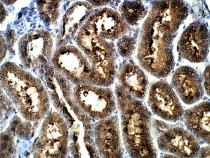ARG11074
anti-SIRT5 antibody
anti-SIRT5 antibody for IHC-Formalin-fixed paraffin-embedded sections and Mouse,Rat,Baboon,Monkey
Overview
| Product Description | Rabbit Polyclonal antibody recognzies SIRT5 |
|---|---|
| Tested Reactivity | Ms, Rat, Bb, Mk |
| Tested Application | IHC-P |
| Host | Rabbit |
| Clonality | Polyclonal |
| Isotype | IgG |
| Target Name | SIRT5 |
| Antigen Species | Human |
| Immunogen | Synthetic peptide within aa. 260-310 of Rat SIRT5. |
| Conjugation | Un-conjugated |
| Alternate Names | SIR2L5; Regulatory protein SIR2 homolog 5; EC 3.5.1.-; NAD-dependent protein deacylase sirtuin-5, mitochondrial; SIR2-like protein 5 |
Application Instructions
| Application Suggestion |
|
||||
|---|---|---|---|---|---|
| Application Note | * The dilutions indicate recommended starting dilutions and the optimal dilutions or concentrations should be determined by the scientist. |
Properties
| Form | Liquid |
|---|---|
| Purification | Affinity purified. |
| Buffer | Tris, HCl / Glycine buffer (pH 7.4 - 7.8), cryo-protective agents, Hepes, 0.02% Sodium azide, 30% Glycerol and 0.5% BSA. |
| Preservative | 0.02% Sodium azide |
| Stabilizer | 30% Glycerol and 0.5% BSA |
| Concentration | 0.66 - 0.68 mg/ml |
| Storage Instruction | For continuous use, store undiluted antibody at 2-8°C for up to a week. For long-term storage, aliquot and store at -20°C. Storage in frost free freezers is not recommended. Avoid repeated freeze/thaw cycles. Suggest spin the vial prior to opening. The antibody solution should be gently mixed before use. |
| Note | For laboratory research only, not for drug, diagnostic or other use. |
Bioinformation
| Database Links | |
|---|---|
| Gene Symbol | SIRT5 |
| Gene Full Name | sirtuin 5 |
| Background | This gene encodes a member of the sirtuin family of proteins, homologs to the yeast Sir2 protein. Members of the sirtuin family are characterized by a sirtuin core domain and grouped into four classes. The functions of human sirtuins have not yet been determined; however, yeast sirtuin proteins are known to regulate epigenetic gene silencing and suppress recombination of rDNA. Studies suggest that the human sirtuins may function as intracellular regulatory proteins with mono-ADP-ribosyltransferase activity. The protein encoded by this gene is included in class III of the sirtuin family. Alternative splicing of this gene results in multiple transcript variants. [provided by RefSeq, Jul 2010] |
| Function | NAD-dependent lysine demalonylase, desuccinylase and deglutarylase that specifically removes malonyl, succinyl and glutaryl groups on target proteins. Activates CPS1 and contributes to the regulation of blood ammonia levels during prolonged fasting: acts by mediating desuccinylation and deglutarylation of CPS1, thereby increasing CPS1 activity in response to elevated NAD levels during fasting. Activates SOD1 by mediating its desuccinylation, leading to reduced reactive oxygen species. Modulates ketogenesis through the desuccinylation and activation of HMGCS2 (By similarity). Has weak NAD-dependent protein deacetylase activity; however this activity may not be physiologically relevant in vivo. Can deacetylate cytochrome c (CYCS) and a number of other proteins in vitro such as UOX. [UniProt] |
| Cellular Localization | Mitochondrion matrix. Mitochondrion intermembrane space. Cytoplasm, cytosol. Nucleus. Note=Mainly mitochondrial. Also present extramitochondrially, with a fraction present in the cytosol and very small amounts also detected in the nucleus. Isoform 1: Cytoplasm. Mitochondrion. Isoform 2: Mitochondrion. [UniProt] |
| Calculated MW | 34 kDa |
Images (1) Click the Picture to Zoom In






